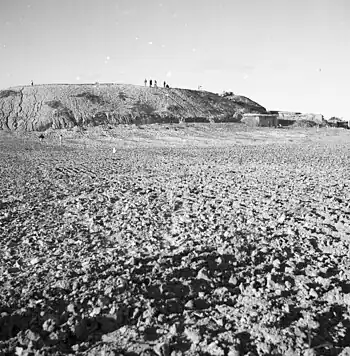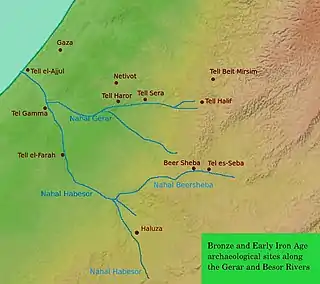Tell el-Ajjul

Tall al-Ajjul or Tell el-'Ajul is an archaeological mound or tell in the Gaza Strip. The fortified city excavated at the site dates as far back as ca. 2000-1800 BCE and was inhabited during the Bronze Age. It is located at the mouth of Wadi Ghazzah just south of the town of Gaza.[1]
History
Archaeologists have excavated remains dated mainly to the Middle and Late Bronze Age.[2]
Middle Bronze IIA
In the MBIIA, Tell el-Ajjul was an important city in the Southern Levant.
Middle Bronze IIB-C
In the MB IIB, the population increased and many sites developed in the southern Levant. Tell el-Ajjul had the largest number of Egyptian Second Intermediate Period imports.[3]
Late Bronze
Large quantities of pumice were deposited during the Late Bronze Age, which may have been caused by the Thera (Santorini) volcanic eruption. If proven correct, this would offer a good correlation and dating tool.[2]
Treaty of Tell Ajul (1229)
The Sixth Crusade came to an end with the so-called Treaty of Jaffa and Tell Ajul.[4] These were in fact two different treaties, the first being the one signed at Tell Ajul by the competing Ayyubid rulers of Egypt, Syria and various smaller principalities. This treaty settled their territorial disputes and left Sultan Al-Kamil of Egypt in a very powerful position. The follow-up treaty was signed at Jaffa by Al-Kamil and the leader of the Sixth Crusade, Emperor Frederick II, thus removing the threat posed to Al-Kamil by the European armies.[5][4]
Identification

Ajjul is one of the proposed sites for Sharuhen and for Beth Eglaim mentioned in Eusebius's Onomasticon, in contrast with Petrie's initial identification with ancient Gaza.[2] Eusebius placed Beth Eglaim at eight Roman miles from Gaza.[2] The name is absent from the Bible, and is given by Eusebius in Greek as Bethaglaim.[6]
In the 1970s, the archaeologist Aharon Kempinski proposed identifying Tall al-Ajjul with Sharuhen, the last stronghold of the Hyksos c. 1550 BCE.
Excavations
In 1930-1934 Tell el-Ajjul was excavated by British archaeologists under the direction of Sir Flinders Petrie, who thought the site was ancient Gaza.[7][8][9][10][11] He was accompanied by Olga Tufnell.[12] One of Flinders Petrie's discoveries were three hoards of Bronze Age gold jewellery, considered to be among the greatest Bronze Age finds in the Levant.[13][14] Most of the collection is preserved at the British Museum in London and the Rockefeller Museum in Jerusalem.[13]
In 1999 and 2000 the excavations were renewed by Peter M. Fischer and M. Sadeq because of a common interest in the protection and exploration of the site, but work was interrupted due to the outbreak of the Second Intifada.[2][15]
A large amount of imported pottery from Cyprus has been discovered. These imports begin with Base-ring I, and White Slip I types of pottery. In particular, over 200 sherds of White Slip I have been found, which pottery is rarely found outside of Cyprus. The majority of the sherds, nevertheless, are of the later White Slip II and Base-ring II wares. There are also sherds of other kinds of Cypriot pottery, including Bichrome Wheel-made, Monochrome, Red Lustrous Wheel-made, and White Painted V/VI. Mycenean pottery and such from Upper Egypt were also found.[2][16]
References
- "II. Preliminary Results | Swedish Archaeology in Jordan, Palestine and Cyprus, Peter Fischer". Retrieved 19 October 2020.
- Avraham Negev and Shimon Gibson (2001). Ajjul (Tell el-). pp. 25–26. ISBN 0-8264-1316-1.
{{cite book}}:|work=ignored (help) - Daphna Ben-Tor (2007) Scarabs, Chronology, and Interconnections, p. 168
- Adrian J. Boas (2001). Jerusalem in the Time of the Crusades: Society, Landscape and Art in the Holy City Under Frankish Rule. London: Routledge. p. 1. ISBN 9780415230001. Retrieved 10 May 2015.
- Humphreys, R. Stephen (1977). From Saladin to the Mongols: The Ayyubids of Damascus 1193-1260. State University of New York (SUNY) Press. pp. 197–198. ISBN 0873952634. Retrieved 10 May 2015.
- Geoffrey William Bromiley, ed. (1979). "Beth-eglaim". The International Standard Bible Encyclopedia. Vol. 1 (reprint, revised ed.). Wm. B. Eerdmans. p. 465. ISBN 9780802837813. Retrieved 9 December 2019.
- Petrie W.M.F. 1931. "Ancient Gaza I: Tell el Ajjūl", (BSAE LIII). London
- Petrie W.M.F. 1934. "Ancient Gaza II: Tell el Ajjūl", (BSAE LIV). London
- Petrie W.M.F. 1933. "Ancient Gaza III: Tell el Ajjūl", (BSAE LV). London
- Petrie W.M.F. 1934. "Ancient Gaza III: Tell el Ajjūl", (BSAE LVI). London
- Petrie W.M.F. 1954. "City of shepherd Kings, and Ancient Gaza V", (BSAE LXIV). London
- Green, John D. M., and Ros Henry, editors. “Tell El-‘Ajjul, 1930-2.” Olga Tufnell’s “Perfect Journey”: Letters and Photographs of an Archaeologist in the Levant and Mediterranean, UCL Press, 2021, pp. 154–98
- British Museum Collection
- Rockefeller Museum website
- Swedish Archaeology in Jordan, Palestine and Cyprus, Tell el-’Ajjul excavations, Season 2000, Preliminary Results -- by Peter Fischer
- Celia J. Bergoffen, Early Late Cypriot Ceramic Exports to Canaan: White Slip I. In : Leaving No Stones Unturned / Hansen Donald P. - Winona Lake : Eisenbrauns, 2002. - p.23-41
Bibliography
Early Descriptions
- Guérin, Victor (1869). Description Géographique Historique et Archéologique de la Palestine. Vol. 1: Judee, pt. 2. (visit in 1863: p. 212 )
Excavation Reports
- Petrie, William Flinders (1931). Ancient Gaza I. London: British School of Archaeology in Egypt, University College.
- Petrie, William Flinders (1932). Ancient Gaza II. London: British School of Archaeology in Egypt, University College.
- Petrie, William Flinders (1933). Ancient Gaza III. London: British School of Archaeology in Egypt, University College.
- Petrie, William Flinders (1934). Ancient Gaza IV. London: British School of Archaeology in Egypt, University College.
- Murray, Margaret A. (1934). Tell El Ajjul Drawings books 1933/34. Doc. no. SRF_187a (278/278). Israel Antiquities Authority Scientific Archive, British Mandatory Collection.
- Petrie, William Flinders; Mackay, Ernest J. H .; Murray, Margaret A. (1952). City of Shepherd Kings and Ancient Gaza V. London: British School of Egypitan Archaeology, University College.
- Fischer, Peter M.; Sadeq, Moain (1999). "Tell el-ʿAjjul 1999. A Joint Palestinian-Swedish Field Project: First Season Preliminary Report". Ägypten und Levant. X.
- Fischer, Peter M.; Sadeq, Moain (2002). "Tell el-ʿAjjul 2000: Second Season Preliminary Report, with contributions by Anne Lykke, Rainer Feldbacher, Michael Weigl and Christa Mlinar". Ägypten und Levant. XII.
- Fischer, Peter M. (2003). "The Preliminary Chronology of Tell El-ʿAjjul: Results of the Renewed Excavations in 1999 and 2000". In Bietak, Manfred (ed.). The Synchronization of Civilizations in the Second Millenium B.C. II: Proceedings of the SCIEM 2000 — EuroConference, Haindorf 2nd of May - 7th of May 2001. Wien: Österreichischen Akademie der Wissenschaften. pp. 263–294.
Subsequent Archaeological Studies
- Artzy, Michal; Asaro, Frank; Perlman, Isadore (1973). "The Origin of the Palestinian 'Bichrome' Ware". Journal of the American Oriental Society. 93 (4): 446–461. doi:10.2307/600164. JSTOR 600164.
- Albright, William F. (1938). "The Chronology of a South Palestinian City, Tell El-ʿAjjul". American Journal of Semitic Languages and Literatures. 55 (4): 335–359. doi:10.1086/amerjsemilanglit.55.4.3088117. S2CID 171054400. (reprinted in Stewart, J. R. (1974). Kassis, Hanna E. (ed.). Tel El-ʿAjjul: The Middle Bronze Age Remains. Göteborg: P. Aströms Förlag.)
- Bergoffen, Celia (1989). A comparative study of the regional distribution of Cypriote pottery in Canaan and Egypt in the Late Bronze Age. Doctoral Dissertation, Department of Fine Arts, New York University. Ann Arbor, Michigan: University Microfilms. pp. 153–210, 390–496.
- Bergoffen, Celia J. (2001). "The Proto White Slip and White Slip I Pottery from Tell El-Ajjul". The White Slip Ware of Late Bronze Age Cyprus: Proceedings of an International Conference Organized by the Anastasios G. Leventis Foundation, Nicosia, in Honour of Malcolm Wiener. Nicosia, 29th-30th October 1998. Wien: Östterreichischen Akademie der Wissenschaften. pp. 145–156.
- Bergoffen, Celia J. (2001). "The Base Ring Pottery from Tell El-ʿAjjul". In Åström, Paul (ed.). The Chronology of Base-ring Ware and Bichrome Wheel-made Ware: Proceedings of a Colloquium held in the Royal Academy of Letters, History and Antiquities, Stockholm, May 18-19 2000. Stockholm: The Royal Academy of Letters, History, and Antiquities. pp. 31–50.
- Epstein, Claire (1966). Palestinian Bichrome Ware. Leiden: E. J. Brill. pp. passim.
- Fischer, Peter M. (2001). "Cypriote Bichrome Wheel-made Ware and Base-ring Ware from the New Excavations Tell El-ʿAjjul: Synchronism and Dating". In Åström, Paul (ed.). The Chronology of Base-ring Ware and Bichrome Wheel-made Ware: Proceedings of a Colloquium held in the Royal Academy of Letters, History and Antiquities, Stockholm, May 18-19 2000. Stockholm: The Royal Academy of Letters, History, and Antiquities. pp. 221–230.
- Gonen, Rivka (1992). Burial Patterns & Cultural Diversity in Late Bronze Age Canaan. Winona Lake, Indiana: Eisenbrauns. pp. 70–82.
- Heurtley, W. A. "A Palestinian Vase-Painter of the Sixteenth Century B. C.". Quarterly of the Department of Antiquities of Palestine. 8: 21–37.
- Kempinski, Aharon (1974). "Tell el-ʿAjjûl — Beth-Aglayim or Sharuḥen?". Israel Exploration Journal. 24 (3–4): 145–152.
- Kempinski, Aharon (1983). Syrien und Palästina (Kanaan) in der letzten Phase der Mittelbronze-zwei-B-Zeit (1650-1570 v. Chr.). Wiesbaden: Harrassowitz. pp. 131–148.
- Kenyon, Kathleen (1956). "Tombs of the Intermediate Early Bronze–Middle Bronze Age at Tell Ajjul". Annual of the Department of Antiquities (Jordan). 3: 41–55.
- Massafra, Angela (2013). "A Group of Metal Weapons from Tell el-ʿAjjul in the Hunterian Museum, University of Glasgow". Vicino Oriente. XVII: 115–133. doi:10.53131/VO2724-587X2013_7.
- Merrillees, Robert S. (1974). "Appendix III: Tell el-ʿAjjul Fine and Imported Wares". In Kassis, Hanna E. (ed.). Tel el-'Ajjul: The Middle Bronze Age Remains. Göteborg: P. Aströms Förlag.
- Negbi, Oren (1970). The Hoards of Goldwork from Tell el-ʿAjjul. Gothenburg: P. Ästrøm.
- Sparks, Rachael Thyrza (2005). "The Lost Loci of Tell el-ʿAjjul: Petrie's Area C". Palestine Exploration Quarterly. 137 (1): 23–29. doi:10.1179/174313005x37943. S2CID 162607846.
- Sparks, Rachael Thyrza (2007). A Future for the Past: Petrie's Palestinian Collection. Essays and Exhibition Catalogue. London: Institute of Archaeology, University College London.
- Stiebeing, William Henry Jr. (1970). Burial Practices in Palestine During the Bronze Age. Doctoral Dissertation, University of Pennsylvania. Ann Arbor, Michigan: University Microfilms. pp. 46–57, 82–84, 101–129, 146–147, 149–150, 162, 166, 231–242, 287–289, 339–353, 389–404, 430–442.
- Stewart, J. R. (1974). Kassis, Hanna E. (ed.). Tel El-ʿAjjul: The Middle Bronze Age Remains. Göteborg: P. Aströms Förlag.
- Tufnell, Olga (1962). "The Courtyard Cemetery at Tell el-Tell el-ʿAjjul, Palestine". Bulletin of the Institute of Archaeology. 3: 1–37.
- Tufnell, Olga (1980). "A Review of the Contents of Cave 303 at Tell el-ʿAjjul". ʿAtiqot. XIV (English Series): 37–48.
Encyclopedia Articles
- Dessel, J. P. (1997). "ʿAjjul, Tell el-". In Meyers, Eric M. (ed.). The Oxford Encyclopedia of Archaeology in the Middle East, Vol. 1. New York and Oxford: Oxford University Press. pp. 38–40.
- Liid, Dale (1992). ""ʿAjjul, Tell el-"". In Freedman, David Noel (ed.). The Anchor Bible Dictionary, Vol. I. New York: Doubleday. pp. 133–134.
- Robertson, Brian Mark (1999). The Chronology of the Middle Bronze Age Tombs at Tell el Ajjul. Doctoral Dissertation, Department of Anthropology, University of Utah. Ann Arbor, Michigan: University Microfilms.*
- Tufnell, Olga (1976). "El-ʿAjjul, Tell (Beth ʿEglayim)". In Avi-Yonah, Michael (ed.). Encyclopedia of Archaeological Excavations in the Holy Land, Vol. I. pp. 52–61.
- Tufnell, Olga; Kempinski, Aharon (1993). "ʿAjjul, Tel". In Stern, Ephraim; Lewinson-Gilboa, Ayelet; Aviram, Joseph (eds.). The New Encyclopedia of Archaeological Excavations in the Holy Land, Vol. I. Jerusalem: Israel Exploration Society & Carta. pp. 49–53.
Museum Collections
- "Institute of Archaeology Collections". Institute of Archaeology Collections. Institute of Archaeology, University College, London. Retrieved 30 June 2015. (Search for "place=Ajjul").